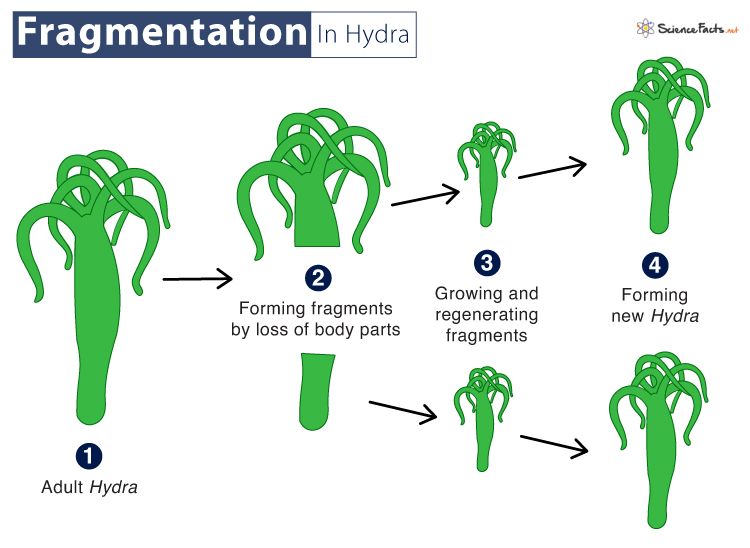Fragmentation is found to occur in fungi such as yeasts and mushrooms. Plants such as ferns, mosses, and cyanobacteria also reproduce by fragmentation. In animals, sea stars are the most common example, although annelid worms, sponges, and flatworms also reproduce by this method.
Steps of Fragmentation
Fragmentation in Fungi and Algae
Fragmentation in Plants
Fragmentation in Animals
Advantages of Fragmentation
Disadvantages of Fragmentation
Fragmentation and Regeneration
Step 1: Formation of fragments by removal of body partsStep 2: Growth and regeneration of fragmentsStep 3: Conversion of fragments into developed individuals
Here, unique structures called hyphae take part in the process. They are the filamentous branches from which the mycelium of the fungi is formed. Before splitting, the hyphae grow on the fungi, from which they derive nutrients. Once mature to feed and reproduce, the hyphae detach from the parent body and start living independently. Certain algae, such as filamentous-shaped Spirogyra, reproduce by forming separate fragments which develop into new individuals. There are also some other forms of fragmentation in plants. Woody plants, like willows, shed twigs, which later grow into a new plant. This process of fragmentation is called cladoptosis. Again plants such as Kalanchoe daigremontiana develop adventitious plantlets on their leaves, which drop off and form independent plants. Fragmentation is also observed in non-vascular plants such as liverworts and mosses. Small pieces of their body, such as stems or leaves, are scattered by the wind, water, or animals. On getting a suitable growth environment, they develop into a new plant. Fragmentation is also used to propagate plants artificially in different ways, such as layering, cuttings, grafting, and micropropagation of storage organs, such as bulbs, corms, tubers, and rhizomes. Most sea anemones also reproduce through fragmentation through longitudinal fission, where the parent’s body divides longitudinally into two halves forming two same-sized anemones. There is another method called basal laceration, where small parts of the parent split from the base to form new anemones. In echinoderms, the process is known as fissiparity. Fragmentation is also common in hydra, starfish, and Planaria.
Shorter generation time and thus organisms grow and develop rapidly compared to those that reproduce through sexual meansForms large number of offspring as the chain of reproduction continues from one individual to two and from two to four, and so on Occur with the help of a single parent and thus can occur easily compared to sexual modes of reproduction where there is a need for a partner (both male and female gametes).Requires less energy expenditure compared to sexual modes of reproduction through the formation of gametesInvolve in specific cellular processes, DNA fragmentation that occurs during DNA cloning and cell fragmentation, the final step of apoptosis
It stops genetic diversity (variation). By fragmentation, all organisms will look the same, and the traits they carry will be a copy of their parent.It increases the chance of extinction of the species. As there is no genetic variation, if a disease is inherited, all the organisms are likely to get affected equally. Also, suppose a trait is not favorable for the environment. Then, each individual will suffer equally and is less likely to be selected by nature. It leads to overpopulation, causing scarcity of food and thus creating a struggle for space and existence within the organisms of the same species.
Most organisms on Earth are capable of regeneration, whereas only a few organisms are capable of fragmentation. Regeneration is frequent in lizards and octopuses.
